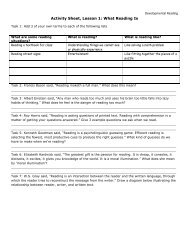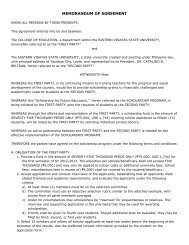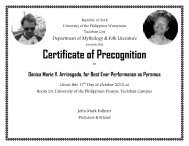PDF handout of the 32 Powerpoints - Mark Fullmer
PDF handout of the 32 Powerpoints - Mark Fullmer
PDF handout of the 32 Powerpoints - Mark Fullmer
You also want an ePaper? Increase the reach of your titles
YUMPU automatically turns print PDFs into web optimized ePapers that Google loves.
6/5/2012The Panjabi model for <strong>the</strong> spinal stabilizing system consists <strong>of</strong> 3interacting subsystems. These are <strong>the</strong> passive system(structure <strong>of</strong> <strong>the</strong> vertebrae, passive stiffness <strong>of</strong><strong>the</strong> intervertebral discs, spinalligaments, joint capsules, and<strong>the</strong> passive properties <strong>of</strong> <strong>the</strong> muscles), active system(contractile properties <strong>of</strong> muscles and tendons),and neural system (proprioceptors and o<strong>the</strong>r neural controlcomponents). The 3 subsystems complement each o<strong>the</strong>r andwork toge<strong>the</strong>r to achieve stability.There are three main categories <strong>of</strong> vocabulary:General vocabularySpecialized vocabularyTechnical vocabularyThese are words that everyone knows and usesas a part <strong>of</strong> everyday communicationThese are words that have specific meaningdepending on <strong>the</strong> content area being covered.For example, <strong>the</strong> word “bar” in a music classrefers to time duration. In a science class, “bar”means a shape. Also, in a math class, <strong>the</strong> word“ruler” means a device to measure things. In ahistory class, it means a leader.These are words that relate very specifically toa content area and are not familiar to peoplewho have not studied that content area. Forexample, do you know <strong>the</strong> word “exegesis”? Aseminarian knows it. But he might not know<strong>the</strong> word “duodenum” while a science majorwould know that word.The Panjabi model for <strong>the</strong> spinal stabilizing system consists <strong>of</strong> 3interacting subsystems. These are <strong>the</strong> passive system(structure <strong>of</strong> <strong>the</strong> vertebrae, passive stiffness <strong>of</strong><strong>the</strong> intervertebral discs, spinalligaments, joint capsules, and<strong>the</strong> passive properties <strong>of</strong> <strong>the</strong> muscles), active system(contractileproperties <strong>of</strong> muscles and tendons),and neural system (proprioceptors and o<strong>the</strong>r neural controlcomponents). The 3 subsystems complement each o<strong>the</strong>r andwork toge<strong>the</strong>r to achieve stability.2







